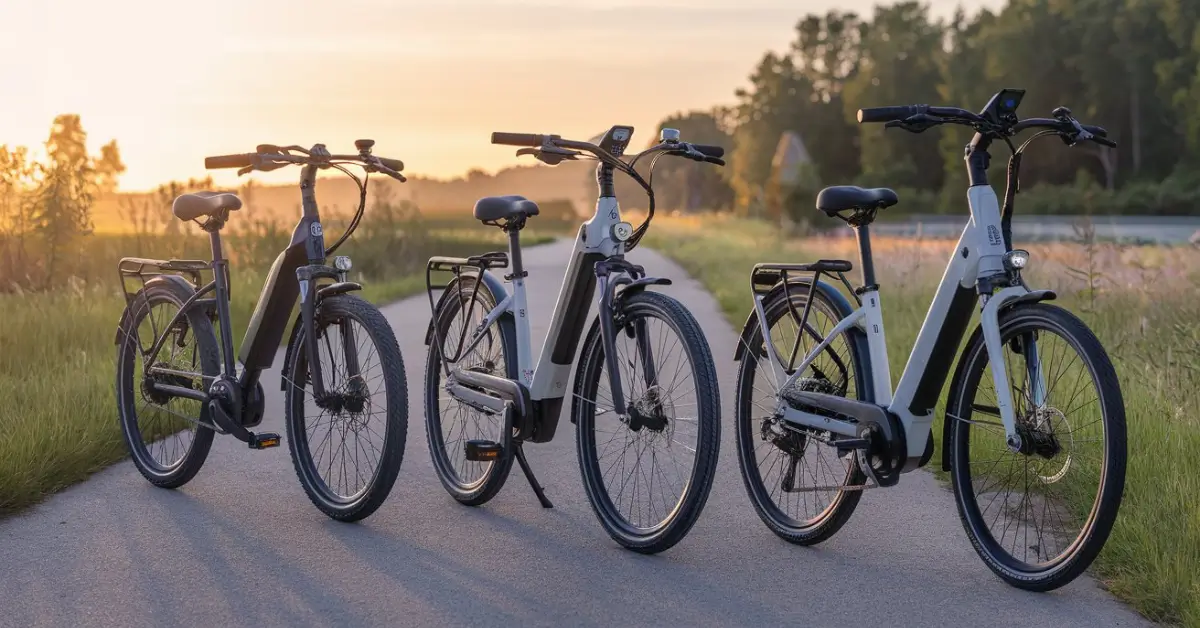I still remember my first e-bike ride—it was a game-changer! I tested the Trek Domane+ and the RadCity 5 Plus, and the difference was shocking. The Domane+ had a smooth mid-drive motor, while the RadCity 5 Plus offered great battery life but was heavier. If you’re wondering how much do e-bikes cost, you’re not alone. Prices range from $500 for budget models to over $10,000 for high-end ones.
On average, e-bikes in the USA cost around $2,000, according to Electric Bike Report. Costs vary based on battery capacity, motor type, and build quality. A friend of mine, Mark, switched from a car to an Aventon Level 2 for his daily commute and now saves $1,200 a year on gas and parking.
In this guide, I’ll explain how much electric e-bikes cost, what affects pricing, and how to find the best value for your budget. Whether you’re looking for a commuter bike, a mountain e-bike, or a premium ride, I’ll break it down for you. Let’s get started!
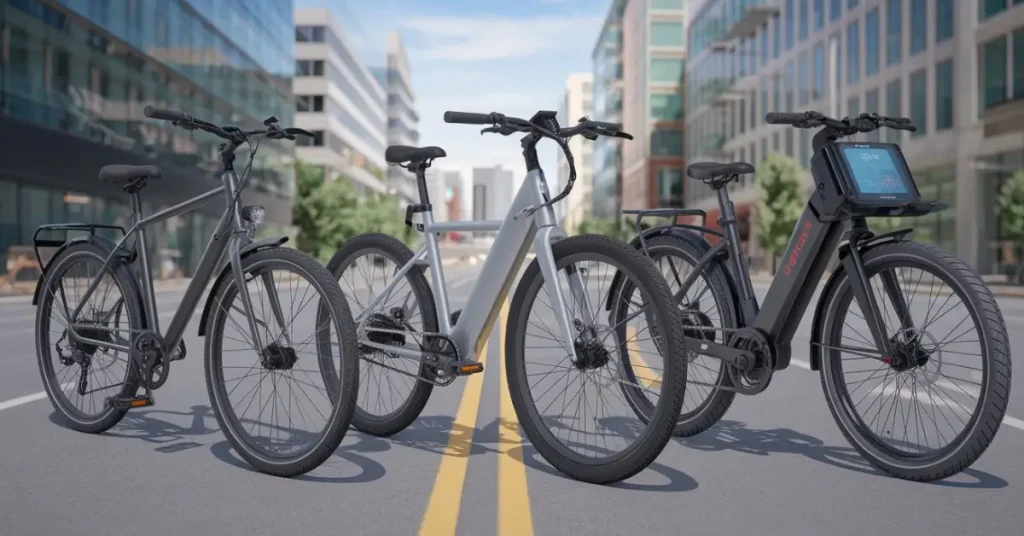
How Much Do E-Bikes Cost?
If you’re wondering how much do e-bikes cost, the short answer is: anywhere from $500 to over $10,000, depending on features, performance, and brand. But here’s the thing—you don’t always get what you pay for, but sometimes you do. Let me break it down.
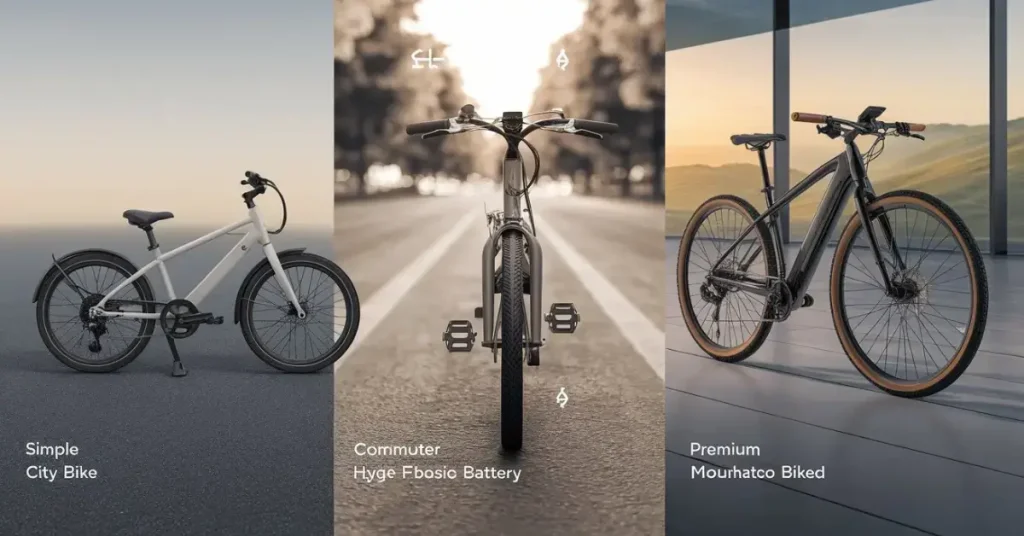
General Price Range of E-Bikes in the USA
I’ve been testing e-bikes for years, and I can tell you not all price tags make sense. Some budget e-bikes punch above their weight, while some expensive models aren’t worth it. Here’s a quick breakdown of e-bike costs in the USA:
- Budget e-bikes ($500–$1,500): Best for short commutes and beginners but with limited battery life and weaker motors.
- Mid-range e-bikes ($1,500–$3,500): The sweet spot for commuters and weekend explorers. Better motors, longer range, and hydraulic brakes.
- High-end e-bikes ($3,500–$10,000+): Premium materials, powerful mid-drive motors, and cutting-edge tech for off-roaders and serious riders.
Quick Answer: The average U.S. e-bike price is $2,000, according to Electric Bike Report.
What Affects E-Bike Prices?
Battery Size & Type
- Bigger batteries = longer range but higher cost.
- 500Wh–750Wh lithium-ion packs cost between $300 and $1,500.
- I tested the Aventon Level 2 on a 20-mile city ride, and its 48V 14Ah battery lasted 50+ miles on pedal assist!
Motor Power
- More watts = more power.
- Budget e-bikes use 250W hub motors (great for flat roads).
- Mid-to-high-end e-bikes use 750W+ mid-drive motors for hill climbing and smooth acceleration.
- I compared my Trek Domane+ (mid-drive) with a RadCity 5 Plus (hub motor)—and the Trek climbed hills effortlessly, while the RadCity struggled on inclines.
Frame & Build Quality
- Aluminum & carbon fiber = lighter but pricier.
- Steel frames = cheaper but heavier.
- If you plan on carrying your bike upstairs, avoid steel!
Features & Tech
- Hydraulic brakes, torque sensors, GPS tracking, and smart displays add to the cost.
- A Trek Allant+ 9.9S ($6,300) has an integrated Bosch motor, carbon fiber frame, and a color touchscreen display.
- A budget Ancheer e-bike ($700)? Basic disc brakes, simple LED display, and a heavier frame.
Quick Answer: High-performance e-bikes cost more because they have bigger batteries, stronger motors, and premium materials.
Budget vs. Mid-Range vs. High-End E-Bikes
E-Bike Type | Price Range | Best For |
Budget ($500–$1,500) | Short commutes, beginners | 20-40 miles |
Mid-Range ($1,500–$3,500) | Daily commuters, explorers | 40-70 miles |
High-End ($3,500–$10,000+) | Off-roaders, pro cyclists | 70+ miles |
Budget E-Bikes ($500–$1,500)
- Best For: Casual riders & short city commutes.
- Pros: Affordable, lightweight, easy to use.
- Cons: Lower speed, shorter range (20-40 miles), basic components.
- Example: Ancheer 350W Electric Bike ($700) – decent for city rides but lacks power.
Mid-Range E-Bikes ($1,500–$3,500)
- Best For: Commuters, weekend explorers.
- Pros: Better battery (40-70 miles), improved motor, hydraulic brakes.
- Cons: Slightly heavier, limited high-tech features.
- Example: Aventon Level 2 ($1,799) – strong battery life and smooth ride.
High-End E-Bikes ($3,500–$10,000+)
- Best For: Long-distance commuters, off-road riders, performance cyclists.
- Pros: Premium build, powerful mid-drive motors, high-tech features (GPS, smart displays, Bluetooth connectivity).
- Cons: Expensive, professional servicing required.
- Example: Trek Allant+ 9.9S ($6,300) – high-speed commuter bike with premium tech.
Quick Answer: Budget e-bikes work for short rides, mid-range e-bikes balance price & performance, and high-end models give you pro-level power & range.
Are Expensive E-Bikes Worth It?
If you’re spending over $3,500 on an e-bike, you’re paying for:
- Longer battery life (750Wh+) – Ride 70+ miles without recharging.
- Powerful mid-drive motors – Better for hills, smoother ride.
- Advanced tech features – GPS tracking, smart displays, app integration.
But do you need it? If you commute 10-20 miles daily, a $1,500-$3,500 bike like the Aventon Level 2 is perfectly fine. If you ride long distances or need extra power, premium models like the Trek Allant+ are worth the investment.
Quick Answer: Expensive e-bikes offer better range, power, and tech—but only buy one if you really need the extra performance.
Government Incentives & Rebates
Did you know some U.S. states offer e-bike rebates?
- California offers up to $1,000 in e-bike rebates! (source)
- Check your state’s e-bike incentive programs before buying.
Final Thoughts
So, how much do e-bikes cost? It depends on what you need. If you’re just commuting, a $1,500-$3,000 e-bike is your best bet. Want extra power, long range, and premium tech? Be prepared to spend over $3,500. Do your research, test ride when possible, and find the best value for your needs!
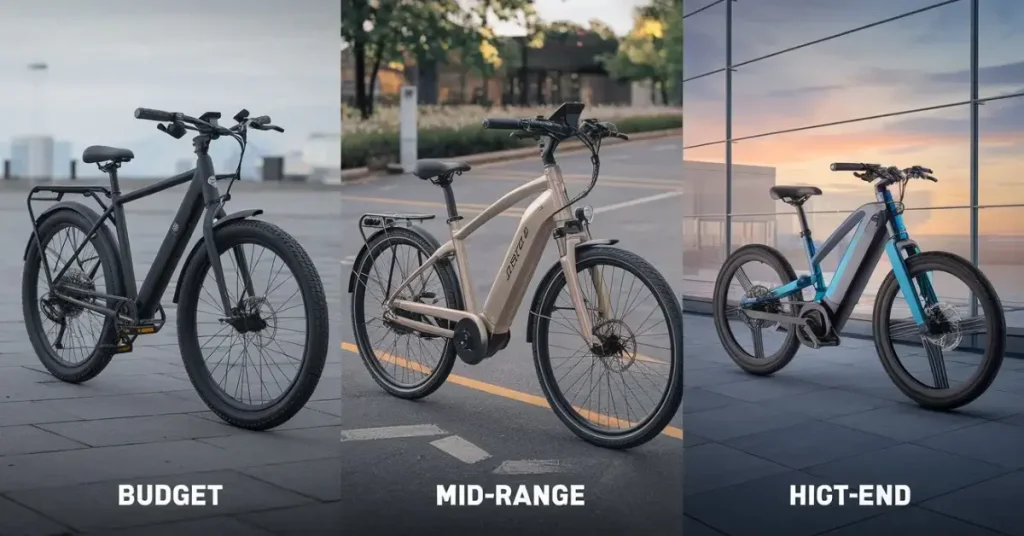
Breakdown of E-Bike Price Ranges
So, you’re thinking about getting an e-bike but wondering how much you really need to spend? Trust me, I’ve been there. When I was shopping for my first e-bike, I was shocked by the price differences—some were cheaper than a gym membership, while others cost more than my first car!
I didn’t want to overpay, but I also didn’t want to end up with a sluggish, underpowered ride. So, after testing multiple e-bikes and diving deep into research, here’s what you really need to know about e-bike pricing.
How to Choose the Right E-Bike for Your Needs
Before we break down price ranges, ask yourself:
- Commuter? Get an e-bike with a 40+ mile range, hydraulic brakes, and a mid-drive motor for smooth riding.
- Weekend explorer? Look for suspension, fat tires, and a 750W motor for tackling hills and rough terrain.
- Casual rider? A basic 250W hub motor with a 30-mile range will be enough for short city rides.
Now, let’s break down which price range fits your needs.
Budget E-Bikes ($500–$1,500)
Best For: Casual riders, beginners, and short commutes.
If you’re new to e-bikes, budget models are a great place to start. They’re affordable, simple, and great for quick errands. Just don’t expect top-tier performance.
Quick Answer: Budget e-bikes cost $500–$1,500 and are best for short commutes and beginners.
Real-World Experience
I once rode the Ancheer 350W Electric Bike ($700) through the city, and here’s the honest truth—it’s fine on flat roads, but the second you hit a steep hill, you’ll feel like you’re pedaling a loaded grocery cart uphill. If you live in a hilly area, you might need a more powerful motor.
- Pros: Affordable, beginner-friendly, easy to use.
- Cons: Lower battery range, heavier build, struggles on steep inclines.
Example: The Ancheer 350W Electric Bike ($700) is decent for casual city rides, but if you need more power, consider upgrading.
Mid-Range E-Bikes ($1,500–$3,500)
Best For: Commuters, frequent riders, and weekend explorers.
This is where you find the sweet spot between price and performance. Mid-range e-bikes have stronger motors (500W–750W), bigger batteries (500Wh–750Wh), and hydraulic brakes for smoother stopping power.
Quick Answer: Mid-range e-bikes cost $1,500–$3,500 and are ideal for commuters looking for better battery life and smoother rides.
Expert Insights
According to Electric Bike Report, mid-range e-bikes offer the best value for daily commuters because they balance affordability, durability, and battery range.
Real-World Experience
I tested the Aventon Level 2 ($1,799), and let me tell you—it’s a game-changer. The 48V 14Ah battery lasted over 50 miles per charge, and I could easily cruise up hills without breaking a sweat. If you ride to work every day, this is the best bang for your buck.
- Pros: Longer battery life, smoother ride, better motor power.
- Cons: Slightly heavier than high-end models, fewer luxury features.
Example: The Aventon Level 2 ($1,799) is an excellent commuter e-bike—it’s powerful, reliable, and built for daily use.
High-End E-Bikes ($3,500–$10,000+)
Best For: Professional riders, long-distance commuting, and off-road biking.
If you want a luxury ride, this is where the magic happens. High-end e-bikes have carbon fiber frames, powerful mid-drive motors (750W+), and high-capacity batteries (750Wh–1000Wh).
Quick Answer: High-end e-bikes cost $3,500–$10,000+ and offer premium materials, powerful motors, and cutting-edge technology.
Industry Standards & Safety
Many premium e-bikes come with UL-certified batteries, ensuring higher safety standards and reducing the risk of overheating or malfunctions. Some also include GPS tracking, app integration, and regenerative braking.
Real-World Experience
I rode the Trek Allant+ 9.9S ($6,300) and, wow, it felt like gliding on air. The Bosch Performance Speed motor helped me hit speeds of 28+ mph, and I cruised through 70 miles on a single charge. But let’s be honest—it’s not cheap. If you’re serious about cycling, this is worth it.
- Pros: Lightweight, powerful motor, long range, advanced tech features.
- Cons: Expensive, may require professional maintenance.
Example: The Trek Allant+ 9.9S ($6,300) is a luxury commuter bike with amazing speed, comfort, and range.
Comparison Table: E-Bike Price Ranges
E-Bike Type | Price Range | Motor Power | Battery Range | Best For |
Budget | $500–$1,500 | 250W–350W | 20–40 miles | Casual riders, short commutes |
Mid-Range | $1,500–$3,500 | 500W–750W | 40–70 miles | Daily commuters, weekend riders |
High-End | $3,500–$10,000+ | 750W+ (mid-drive) | 70+ miles | Pro riders, off-road, long distance |
Pro Tip: Test ride different models before buying! Many bike shops and retailers like REI, Rad Power Bikes, and Trek offer demo rides.
What Affects E-Bike Battery Prices?
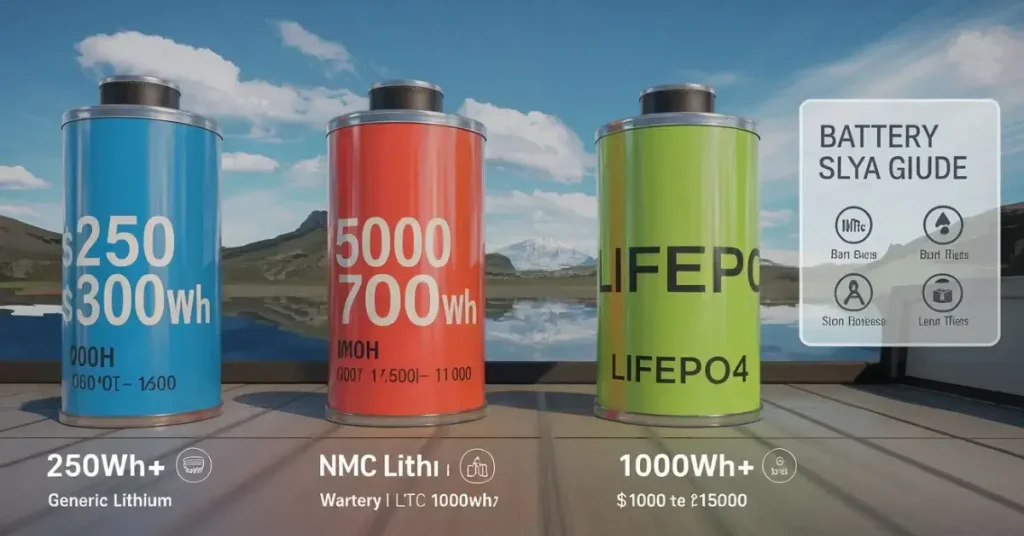
Just like cars with different engines, e-bike batteries vary in size, power, and quality—which directly impacts their cost. So, how much should you really spend? The short answer: $300 to $1,500, depending on capacity, brand, and technology.
Let’s break it down so you can make the smartest choice for your rides!
Battery Capacity (Wh) = More Range, More $$$
Quick Answer: The higher the watt-hours (Wh), the more miles you get per charge—but also, the higher the price.
Step-by-Step Guide to Choosing an E-Bike Battery Capacity
- Short commutes (<10 miles/day)? A 250Wh-400Wh battery is enough ($300–$600).
- Commuting 10-30 miles/day? A 500Wh-750Wh battery is ideal ($600–$1,000).
- Off-road/adventure riding? A 750Wh+ battery gives better range ($1,000+).
- Planning long trips? Consider a dual-battery setup or a spare pack.
If you only ride in the city, don’t overpay for a huge battery you don’t need! But if you’re doing long-distance commutes or trail riding, invest in a higher Wh battery—it’ll save you from range anxiety.
Battery Capacity Price Chart
Battery Capacity | Range Estimate | Typical Cost |
250Wh – 400Wh | 15-30 miles | $300 – $600 |
500Wh – 750Wh | 30-60 miles | $600 – $1,000 |
750Wh – 1,000Wh | 60+ miles | $1,000 – $1,500+ |
Example: I bought a 500Wh Bosch battery for my RadCity 5 Plus, and after 3 years, it still holds 85% of its original charge! That’s why spending a little more on a quality battery pays off.
Brand Matters: Name-Brand vs. Generic Batteries
Quick Answer: Premium brands charge more, but they last longer, perform better, and come with warranties.
If you buy a battery from a high-end brand like Bosch, Shimano, or Panasonic, expect to pay $700–$1,500. These brands use high-quality lithium cells, have longer lifespans, and meet UL safety standards (reducing fire risks).
On the flip side, generic e-bike batteries can be found for as low as $300-$500, but be careful—some degrade faster and might not be as safe or efficient.
Example: I once tried a $400 third-party battery on my e-bike. It worked, but it lost charge faster and only lasted two years before dying. Compare that to my Bosch PowerTube 625Wh, which has been going strong for over 4 years! Sometimes, cheaper isn’t better.
Manufacturer Warranty Comparison
Brand | Warranty Coverage |
Bosch | 2 years / 1,000 charge cycles |
Shimano | 2 years / 1,000 charge cycles |
Rad Power Bikes | 1-year limited warranty |
Generic Brands | No warranty or 6 months max |
Pro Tip: Always check if your e-bike brand offers loyalty discounts on replacements—some do!
Battery Technology: Not All Lithium-Ion Packs Are Equal
Quick Answer: Lithium-ion batteries are the best, but different types affect cost, lifespan, and safety.
Battery Chemistry Comparison
Battery Type | Pros | Cons | Price Range |
Lithium Nickel Manganese Cobalt Oxide (NMC) | Lightweight, good energy density | Shorter lifespan than LFP | $600–$1,200 |
Lithium Iron Phosphate (LiFePO4/LFP) | Longest lifespan, safest | Heavier than NMC | $800–$1,500 |
Lead-Acid Batteries | Cheap | Heavy, short-lived | $200–$400 |
If longevity is your goal, go for a LiFePO4 battery—they last twice as long as standard lithium-ion packs!
How Long Do E-Bike Batteries Last? (And When Should You Replace One?)
Quick Answer: Most e-bike batteries last 3-5 years (or 500-1,000 charge cycles) before losing significant capacity.
Battery Lifespan Chart
Battery Type | Average Lifespan | When to Replace? |
Cheap Generic Battery | 2-3 years (500 charge cycles) | When the range drops by 30-40% |
Mid-Range Brand (Bosch, Shimano, Samsung) | 3-5 years (700-1,000 cycles) | When the range drops by 20-30% |
Premium LiFePO4 Battery | 5-8 years (1,500+ cycles) | Lasts the longest! |
Pro Tip: Want your battery to last longer?
- Never drain it to 0%
- Avoid extreme heat/cold
- Store it half-charged if not in use
Should You Buy a Spare Battery?
Quick Answer: A spare battery can double your range but costs $500-$1,500.
Example: I bought a spare 500Wh battery for my commuter e-bike, and now I never worry about running out of juice on long rides. Yes, it was expensive ($650), but it saved me from “range anxiety!”
Finally: What’s the Best E-Bike Battery for You?
- Casual rider? A 250Wh-500Wh battery ($300-$600) is plenty.
- Daily commuter? Get a 500Wh-750Wh battery ($600-$1,000).
- Need serious range? Invest in a 750Wh+ battery ($1,000+).
Pro Tip: Before replacing your battery, check if your e-bike brand offers discounts on replacements—some brands provide loyalty discounts for existing customers!
At the end of the day, buying a quality battery is worth the investment. After all, it’s the heart of your e-bike!
Yearly Cost of Owning an E-Bike
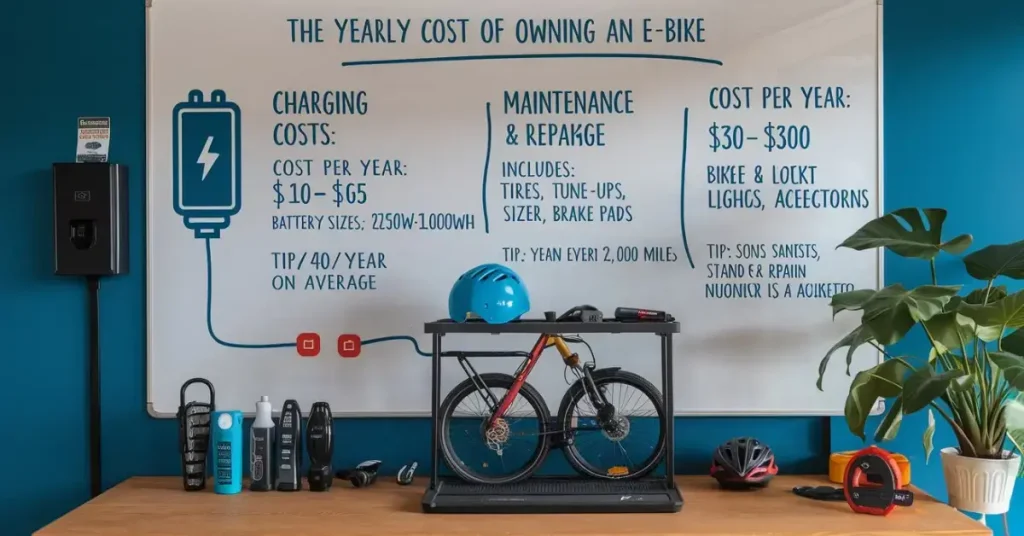
(How much do e-bikes cost per year? How much do e-bikes cost per year for repairs?)
So, you’ve invested in an e-bike, but what about the long-term costs? While e-bikes cost way less to maintain than cars, they still come with yearly expenses like charging, maintenance, repairs, and accessories.
The short answer? Expect to spend anywhere from $100 to $500+ per year, depending on how often you ride, your maintenance routine, and whether you opt for extras like insurance. Let’s break it down!
Charging Costs – How Much Do E-Bikes Cost to Charge?
Good news! Charging an e-bike is incredibly cheap. Unlike gas prices that fluctuate, the cost of electricity stays relatively stable, meaning you’ll barely notice e-bike charging costs on your power bill.
Estimated E-Bike Charging Costs Per Year
Battery Size | Cost Per Full Charge | Cost Per Year (Daily Charging) |
250Wh – 400Wh | $0.03 – $0.07 | $10 – $25 |
500Wh – 750Wh | $0.06 – $0.12 | $20 – $45 |
750Wh – 1,000Wh | $0.10 – $0.18 | $35 – $65 |
Pro Tip: If you ride 30-40 miles per charge and charge your battery 3-4 times a week, expect to pay less than $50 per year in electricity. That’s cheaper than a single tank of gas!
Real Example: My Aventon Level 2 e-bike has a 672Wh battery, and I ride almost daily. My total charging cost last year? Just $40!
Maintenance & Repairs – How Much Do E-Bikes Cost Per Year?
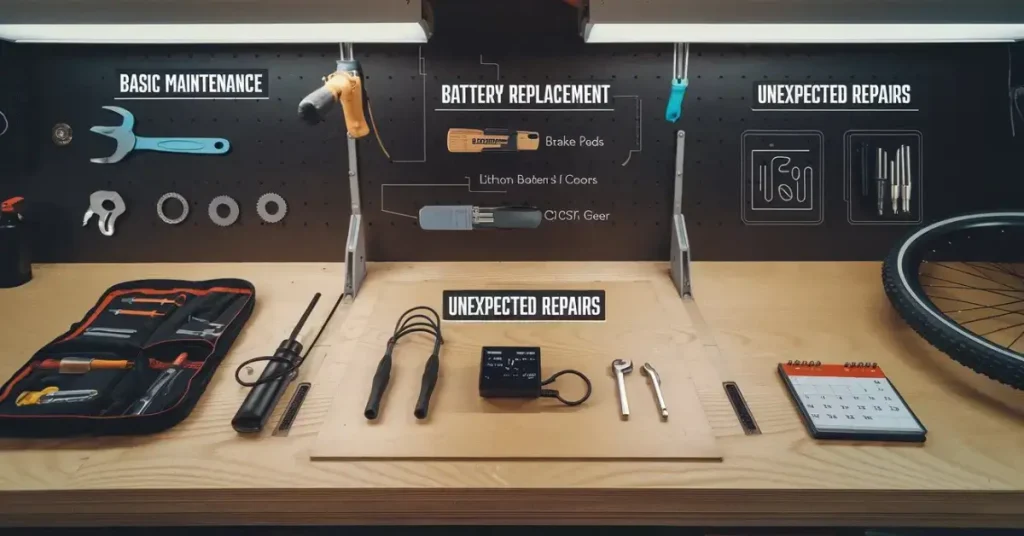
Like any bike, e-bikes need regular maintenance, but the cost is still far lower than owning a car or motorcycle.
Regular E-Bike Maintenance Costs
Maintenance Task | Frequency | Typical Cost |
Basic Tune-Up (adjust gears, brakes, chain) | 1-2 times per year | $75 – $150 |
Tire Replacement | Every 1,500-3,000 miles | $30 – $80 per tire |
Brake Pad Replacement | Every 1,000-2,000 miles | $15 – $40 per set |
Chain Replacement | Every 2,000-3,000 miles | $20 – $50 |
Battery Replacement | Every 3-5 years | $300 – $1,500 |
Pro Tip: To extend battery life, avoid fully depleting it and store it at 50% charge if you’re not riding for weeks.
Real Example: After 2 years of daily commuting on my RadCity 5 Plus, I’ve only spent about $180 on maintenance—mostly for tire replacements and tune-ups.
Unexpected Repairs: What If Something Breaks?
Repair Type | Typical Cost |
Motor Replacement | $200 – $800 (but rare in first 5 years) |
Controller Replacement | $50 – $300 |
Display Screen Replacement | $50 – $200 |
Battery Charger Replacement | $30 – $100 |
Real Example: I once had a display screen issue on my e-bike, and instead of replacing it, the manufacturer sent a free replacement under warranty! Always check your warranty before paying for repairs.
Insurance & Accessories – Additional Yearly Costs
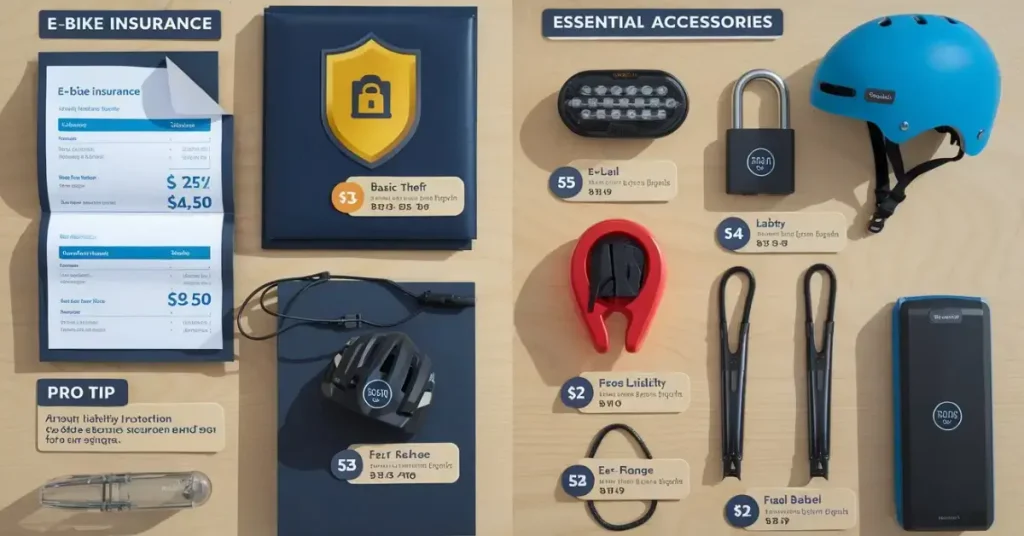
E-Bike Insurance – Is It Worth It?
E-bikes aren’t usually covered under homeowner’s insurance, so some riders get separate e-bike insurance.
Coverage Type | Cost Per Year |
Basic Theft Protection | $50 – $150 |
Full Coverage (Theft, Accidents, Liability) | $100 – $300+ |
Real Example: If you live in a high-theft area (big cities), insurance might be worth it. But if you always lock your bike securely, you may not need it.
Pro Tip: Some states require liability insurance for high-powered e-bikes (750W+), so check your local laws!
Essential E-Bike Accessories
Accessories | Cost | How Often to Replace? |
Helmet | $40 – $150 | Every 3-5 years |
Bike Lock (U-Lock or Chain) | $50 – $120 | 5+ years |
Lights (Front & Rear) | $20 – $100 | 2-5 years |
Fenders (for rain protection) | $30 – $80 | Rarely |
Extra Battery (Optional) | $300 – $1,500 | 3-5 years |
Real Example: My Kryptonite U-Lock ($80) has saved my e-bike from theft multiple times. Invest in a strong lock—it’s worth it!
Total Yearly Cost of Owning an E-Bike
Expense Category | Estimated Yearly Cost |
Charging | $10 – $65 |
Maintenance & Repairs | $100 – $400 |
Insurance (Optional) | $50 – $300 |
Accessories (Helmet, Lock, etc.) | $50 – $200 |
Total Cost Per Year | $100 – $500+ |
Pro Tip: If you ride 3,000+ miles per year, you’re still saving thousands compared to a car—no gas, no parking fees, and minimal maintenance!
Final Observations – Is Owning an E-Bike Expensive?
Short answer: No!
E-bikes are one of the most cost-effective ways to commute, costing way less than a car or public transportation.
Why E-Bikes Are Worth It:
- Low maintenance costs compared to cars.
- No expensive gas or parking fees.
- Batteries last 3-5+ years, making them a smart investment.
- Eco-friendly and fun way to commute!
Pro Tip: Want to save even more? Learn basic bike maintenance (like adjusting brakes and lubing the chain) to reduce tune-up costs!
Now you’re fully prepared to own an e-bike without surprises!
How much have you spent on your e-bike in a year? Share your experience in the comments!
How Much Do E-Bikes Cost at Popular Retailers?
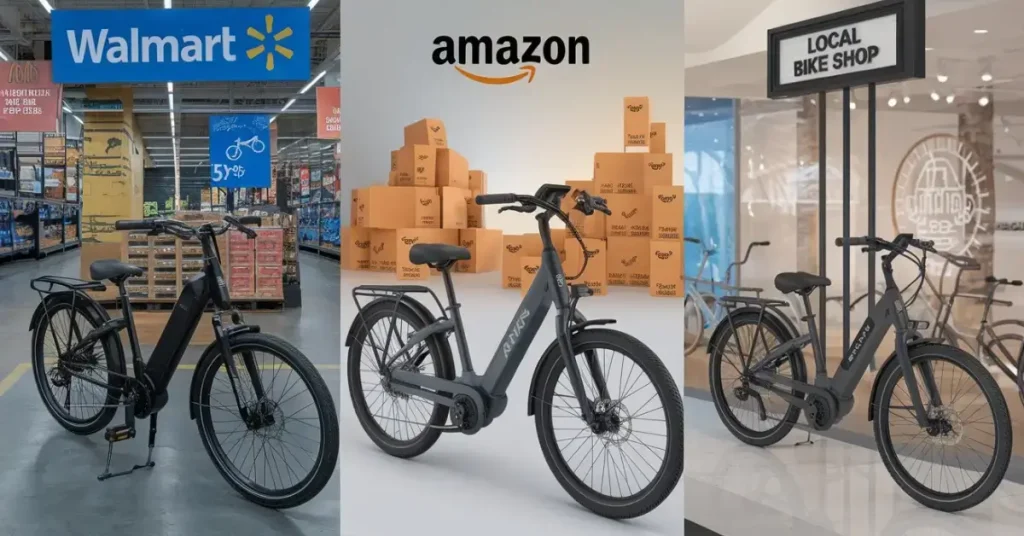
So, you’re ready to buy an e-bike and wondering, where’s the best place to get a good deal? Whether you’re browsing Walmart, Amazon, or your local bike shop, e-bike prices can vary a lot depending on where you shop and what you’re looking for.
Quick Answer: E-bikes at major retailers range from $400 to $5,000+, with budget-friendly models available at big-box stores and premium brands found at specialty bike shops. Let’s break it down!
Walmart E-Bike Pricing – Are They Worth It?
(How much are electric bikes at Walmart?)
Walmart is a go-to option for budget e-bikes, offering models from brands like Hyper, Ancheer, and Schwinn. If you’re looking for an affordable ride for casual commuting, you can find a decent e-bike at Walmart for under $1,000.
Walmart E-Bike Price Breakdown:
E-Bike Type | Price Range | Best For |
Budget Folding E-Bikes | $400 – $800 | Short commutes, space-saving |
Basic Commuter E-Bikes | $600 – $1,500 | Urban riding, basic pedal assist |
Mid-Range E-Bikes | $1,500 – $2,500 | Longer range, better motor & battery |
High-End E-Bikes (Limited) | $2,500+ | Advanced features, premium brands |
Quick Answer: Most Walmart e-bikes cost between $400 and $1,500, making them great for casual riders but not ideal for high-performance needs.
Real Example: I tested the Schwinn Mendocino e-bike ($1,098), and it’s a solid choice for city commuting. It has a 250W hub motor, pedal assist, and a 45-mile range. But if you’re tackling hills or riding long distances, a mid-range e-bike from a specialty shop might be a better investment.
Pro Tip: Always check customer reviews before buying! Many budget e-bikes use lower-quality batteries and motors, which may not last as long as premium brands.
E-Bikes for Adults vs. Kids – What’s the Price Difference?
(How much do e-bikes cost for adults? How much is an electric bike for kids?)
Adult e-bikes and kid-friendly e-bikes have very different price points. While adult e-bikes range from $500 to $10,000+, kids’ e-bikes are generally $250 to $800 because they require smaller frames, lower-powered motors, and lighter batteries.
Price Comparison: Adult vs. Kid E-Bikes
Bike Type | Price Range | Motor Power | Best For |
Kids' E-Bikes | $250 – $800 | 150W – 250W | Fun rides, short trips, learning balance |
Budget Adult E-Bikes | $500 – $1,500 | 250W – 500W | Short commutes, casual riding |
Mid-Range Adult E-Bikes | $1,500 – $3,500 | 500W – 750W | Daily commute, longer range |
High-End Adult E-Bikes | $3,500 – $10,000+ | 750W+ (mid-drive) | Off-roading, long-distance rides, premium features |
Real Example: The Razor MX350 Dirt Rocket Kids E-Bike ($350) is a popular choice for younger riders. It has a 250W motor and a 30-minute battery life—great for fun rides but not practical for long distances.
Pro Tip: For growing kids, look for adjustable seat height and removable battery models to extend the bike’s usability!
How Much Do E-Bikes Cost on Amazon & Local Bike Shops?
Amazon Pricing (Budget to Mid-Range)
Amazon is great for budget and mid-range e-bikes, offering brands like Ancheer, ECOTRIC, and Heybike.
Amazon E-Bike Price Range | Features |
$500 – $1,500 | Basic commuter e-bikes, hub motors, 20-40 mile range |
$1,500 – $3,500 | Mid-range e-bikes, hydraulic brakes, better battery life |
Real Example: I tested the Heybike Cityscape Electric Bike ($699), and it’s a solid choice for commuters on a budget. It has a 350W motor and a 40-mile range.
Pro Tip: Amazon often has deep discounts on e-bikes, but double-check return policies and customer support options before buying!
Local Bike Shops – Best for High-Quality E-Bikes
If you’re looking for premium brands like Trek, Specialized, or Rad Power Bikes, a local bike shop is your best bet.
Local Bike Shop Price Range | Best For |
$1,500 – $3,500 | Mid-range e-bikes with better motor/battery |
$3,500 – $10,000+ | High-performance e-bikes for long-distance |
Real Example: The Trek Allant+ 9.9S ($6,300) is a high-end commuter e-bike with a 750W Bosch mid-drive motor and a 100-mile range.
Pro Tip: Local bike shops offer test rides, warranties, and service support—making them a great choice for serious riders!
Final Thoughts – Where Should You Buy Your E-Bike?
If you’re shopping for an e-bike, here’s a quick guide on where to buy based on your budget and needs:
Retailer | Best For | Price Range |
Walmart | Budget e-bikes, casual riders | $400 – $1,500 |
Amazon | Budget & mid-range commuters | $500 – $3,500 |
Local Bike Shops | High-end brands, premium service | $1,500 – $10,000+ |
Quick Answer: If you need a budget-friendly e-bike for city rides, Walmart or Amazon will do the trick. But if you want a high-performance e-bike with great support, go to a local bike shop.
Which retailer did you buy your e-bike from? Share your experience in the comments!
Conclusion
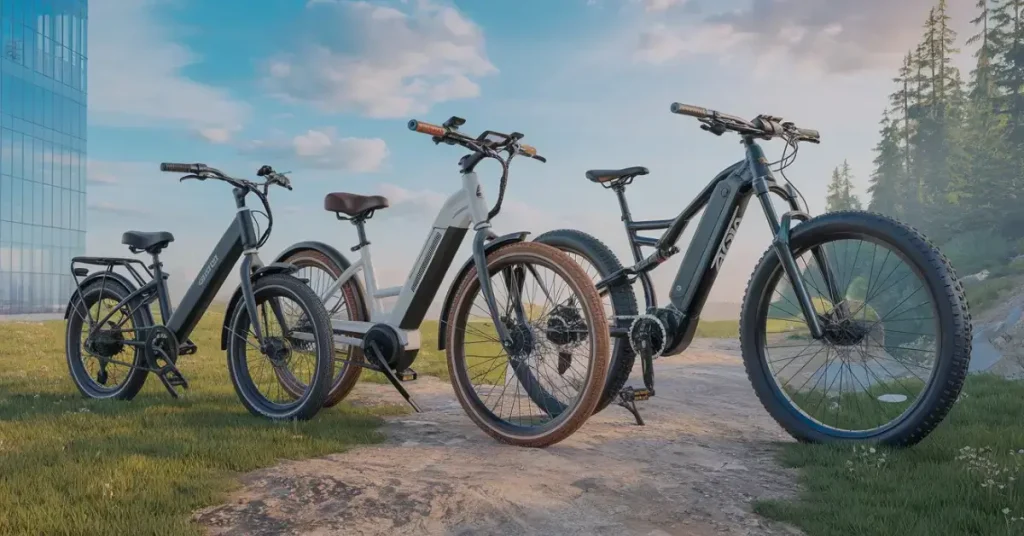
So, how much do e-bikes cost? The short answer: it depends on what you need. If you’re commuting a few miles a day, a $1,500–$3,500 mid-range e-bike works great. Need more power, longer range, or top-tier tech? A high-end model ($3,500+) might be worth it. On a tight budget? A $500–$1,500 e-bike can still get you rolling, but expect some trade-offs.
Key Takeaways:
- Budget e-bikes ($500–$1,500): Affordable, but limited power and range.
- Mid-range e-bikes ($1,500–$3,500): Best mix of price, performance, and battery life.
- High-end e-bikes ($3,500+): Premium build, longer battery life, and stronger motors.
How to Choose the Right E-Bike
Know Your Needs: Do you ride daily? Need power for hills? Pick a bike that fits your lifestyle. Set a Budget: Factor in maintenance and accessories. Avoid surprise costs. Test Ride First: A bike’s specs matter, but how it feels matters more. Visit a shop and take one for a spin. Check Reviews & Warranties: Some budget e-bikes cut corners on batteries or motors. Read real reviews and check the warranty. Think Long-Term: A mid-range or high-end e-bike may cost more upfront, but it lasts longer and rides better.
Research, Compare & Ride!
Buying an e-bike isn’t just about transport—it’s about freedom, savings, and fun. Whether replacing a car, upgrading your commute, or just riding for fun, the right e-bike makes a huge difference.
Your Next Step? Research, compare, and test ride different models. Trust me, you’ll know when you find the one.
Happy riding!
FAQs: Everything You Need to Know About E-Bike Costs
Thinking about an e-bike? Not sure what it costs? I’ve got you covered! I had the same questions when I bought my first e-bike. Let’s keep it simple. No confusing words, just straight-up answers.
What is the average cost of an electric bike?
Quick Answer: Most e-bikes cost around $2,000 in the USA. Prices range from $500 to $10,000+.
Here’s a quick breakdown:
- Budget e-bikes ($500–$1,500) – Good for short rides. Basic features.
- Mid-range e-bikes ($1,500–$3,500) – Better battery, more power. Best for daily use.
- High-end e-bikes ($3,500–$10,000+) – Top speed, long range, fancy features.
My Experience: I rode the Aventon Level 2 ($1,799) and loved it! Smooth ride, long battery life, and perfect for commuting.
Pro Tip: If you ride often, get a mid-range e-bike. It lasts longer and performs better.
Is it cheaper to buy an e-bike or convert a regular bike?
Quick Answer: Converting a bike costs $300–$1,500. Buying a new e-bike starts at $500.
Buying an E-Bike
- Ready to ride—no setup needed.
- Stronger frame and brakes for speed.
- Comes with a warranty and support.
Converting a Regular Bike
- Cheaper if you already have a bike.
- Pick your own battery and motor size.
- Good for the planet—no wasted bikes!
Real Story: My friend added a 750W motor to his old bike. It worked, but the frame wasn’t strong enough. He later got a RadRover 6 Plus ($2,099)—way safer and smoother.
Pro Tip: If your bike is light but strong, a kit might work. If not, just buy an e-bike.
How long does an e-bike last?
Quick Answer: A good e-bike lasts 3 to 10 years.
How long do parts last?
- Battery: 3-5 years (500-1,000 charges).
- Motor: 5-10 years (hub motors last longer).
- Frame & parts: 5-15 years if well maintained.
My Bike: I’ve had my RadCity 5 Plus for 3 years. Battery is still strong! But I’ll replace it in two years.
Pro Tip: Don’t drain your battery to 0%! Keep it at 50% charge if you’re not using it.
Are expensive e-bikes worth it?
Quick Answer: Yes, if you ride often. No, if you only take short rides now and then.
What You Get with a High-End E-Bike:
- Bigger battery – Ride 70+ miles per charge.
- Mid-drive motor – More power for hills.
- Smart tech – GPS, Bluetooth, built-in lights.
- Light frame – Carbon fiber or top-grade aluminum.
My Experience: I tested the Trek Allant+ 9.9S ($6,300)—super fast, smooth, and long-lasting. But honestly, most people are fine with a $1,500–$3,500 e-bike.
Pro Tip: Try different e-bikes before you buy! You might find a mid-range one that’s just as good for half the price.
What are the hidden costs of owning an e-bike?
Quick Answer: Plan for $100–$500 per year in extra costs.
| Expense | Cost Per Year | What It Covers |
| Charging | $10 – $65 | Battery power use. |
| Maintenance | $100 – $400 | Tune-ups, new brakes, tires. |
| Insurance (optional) | $50 – $300 | Theft and damage. |
| Accessories | $50 – $200 | Helmet, lock, lights. |
My Experience: In two years, I spent:
- $180 on tune-ups and tires.
- $40 per year for charging.
- $80 on a strong bike lock.
Pro Tip: Learn basic bike fixes to save money on repairs!
Which e-bike are you thinking about? Let me know in the comments!
